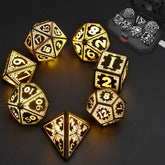How to Build A DND World
Although tabletop games like 'Dungeons & Dragons' offer a plethora of established settings to choose from, many Dungeon Masters may want to embark on the creative journey of building their own worlds. This process is commonly known as 'world building.'

This guide will walk you through the steps of creating your own D&D world, from inception to implementation, helping you transform imaginative ideas into reality.
1. Set the Tone for Your Game World
When constructing your game world, you must establish its tone. What kind of world do you envision? Is it cyberpunk, steampunk, science fiction, or a darker fantasy realm? The world's tone will influence everything in your game. Therefore, at the outset, consider what style of world you want. Find Your World Tone
2. Supplement Your Knowledge
While your ideas for the world are still evolving, you can spark your creativity by reading books, watching movies, and diving into D&D videos. Expanded DND Knowledge
3. Formulate Core World Rules
You must define the core conflicts and rules of your world. The world's subsequent developments will revolve around these established rules. For instance, does your world emphasize magic or technology, and to what extent? What is the central objective of your world? Is it military warfare, political intrigue, or treasure hunting? DND Basic Rules

4.Rules Centered Around Characters
Once the fundamental concepts for the world are in place, you can start thinking about the races, factions, organizations, and their respective cultures, histories, beliefs, and skills within your world. This is a crucial step in world creation.
5. Create a World Map
Sketch out a rough world map, including climate, geography, prominent structures, and the general locations of different races. Create World Map
6. Specific Aspects of the Game
This step encompasses game tasks, plot elements, adventure locations, player skill acquisition, leveling-up rules, monster creation, and NPC establishment. These aspects can be gradually refined in the course of your game.
7. Basic Game Manual
When inviting players to join, you need to explain the game's structure and basic rules. This requires dedicated documentation to introduce players to your rich and expansive world. You can incorporate what you have envisioned when setting up the game rules.
8. Prepare Game Props
For the final preparations of your game, ensure you have essential props. Typically, a D&D game requires maps, dice, character sheets, and character reference sheets. You can get all these ready before the game.
When creating a D&D world, the goal is to play within that environment. Dungeon Masters may spend their lives building the world, but it may never be entirely complete. It's essential to remember that not every part of the setting needs to be fully prepared before playing. Starting from setting the world's tone, filling it with conflicts, creating interesting NPCs, and giving your world depth, working collaboratively with your players, you can craft a world they'll remember for years to come.
Incorporate these elements into your D&D world, and you'll find that it becomes a dynamic and ever-evolving canvas for epic adventures.








